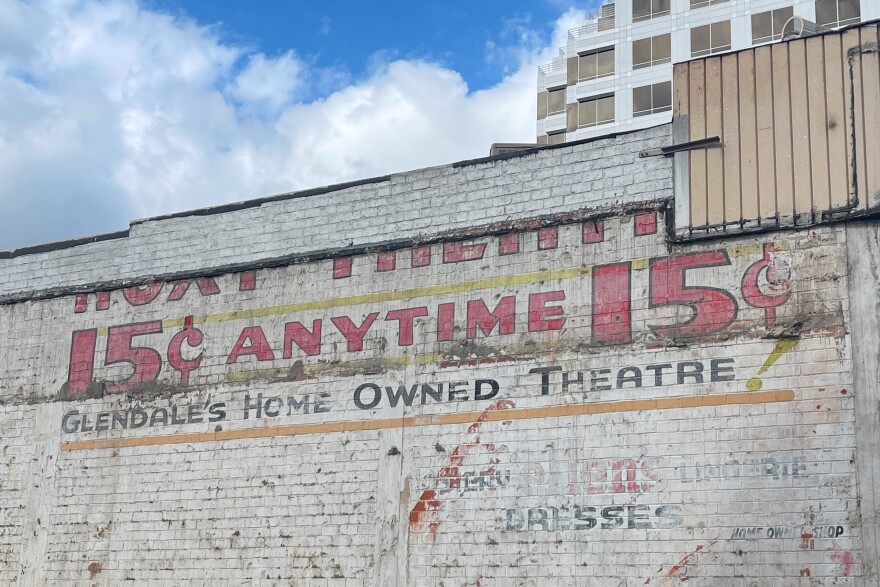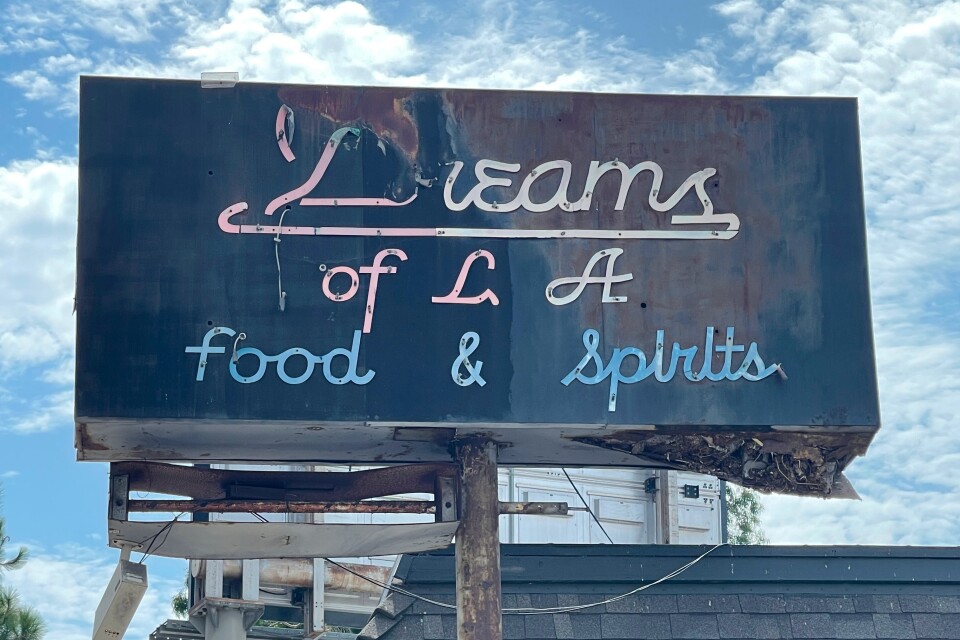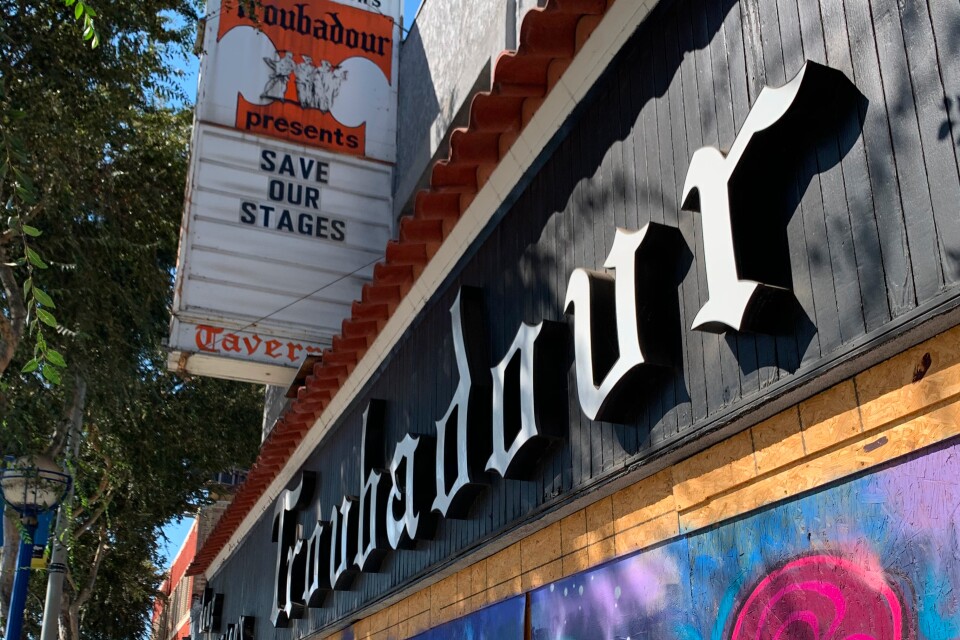Truth matters. Community matters. Your support makes both possible. LAist is one of the few places where news remains independent and free from political and corporate influence. Stand up for truth and for LAist. Make your tax-deductible donation now.
What The Signs Of Los Angeles Say About The City

Walking down the street early in the pandemic, Jason Horton noticed that everything was darker than normal. It wasn’t just early pandemic feelings — Horton, a writer and comedian, realized that a neon sign that normally lit up his neighborhood was off, shut down thanks to COVID-19.
In Signs of Los Angeles: Lost in the Dark, Horton shares photos of the city’s signs and storefronts. He’d already been planning the book and had started putting it together in March 2020. But once the pandemic started and it began to affect businesses around the city, it gave him an added sense of urgency.
“You go by and are like, ‘Oh, this will be here forever.’ And then you go, and it’s like, it’s not. It’s gone,” Horton said. “And I’ll be like, ‘I’ll get it next time.’ And for me, today is next time. This is next time.”
Without knowing what the city would look like going forward, he started taking as many photos as he could. He just knew that the city was going to change, faster than it would without the pandemic.
Why He Didn’t Use The Word ‘Pandemic’ In His Book

Horton had a sense of ambivalence about his book early on, as he began writing it in an unexpected context.
“I was just like, ‘I don’t know if a book is something that I’m even going to want to do,’” Horton said. “How important is it to put out a book about Los Angeles?”
He felt a sense of turbulence in the city, but didn’t want to put the downer feelings of the moment into the book.
“I didn’t want to put something out there to remind people, ‘Hey, remember how bad things were?’ Or how bad things are, or how they could get,” Horton said.
As part of that, Horton intentionally left the word “pandemic” out of his writing.
“I didn’t want that printed there, forever, because we know what’s going on,” Horton said. "We don’t need to be reminded of that again. I don’t need that in this book, 'til the end of time.
“Which could be in a year,” he quipped.
Ultimately, the final version is infused with more hope than some early drafts. Even so, Horton believes that the book is darker than it would have been pre-COVID-19.
Remembering What L.A. Was And Is

Horton finally found peace with sharing his perspective on the city through these images — though it took him six months longer than the date he’d initially promised the publisher. Ultimately, Horton said, Los Angeles is the author behind what he’s putting out.
“It’s not like a thing about, ‘Let me tell you about me, and how cool I am, walking around L.A. — cool L.A. stories about me,’” Horton said.
He wanted to do something more meaningful than just make a book full of fun pictures of the city.
“Not just ‘L.A.’s great, let’s check out 20 local hotspots!’ One of those things like ‘20 Fun Things To Do With Summer In L.A.!’ Which are fine. I love those, I look at those — I mean, they’re something I miss,” Horton said. “But that’s not how I felt, and I could not make that. All I could make was this.”

Horton uses photos that evoke vibes of the city, like a rusted liquor store sign advertising “Dreams of Los Angeles.”
Using Nostalgia To See The Future

The book chronicles changes in the city, from the remnants of the old Amoeba Records sign to pandemic messages on the marquees of closed-down movie theaters.
“For me and where I am in life, nostalgia is a huge part of this book inherently,” Horton said. “Not that I love living in the past, but I love celebrating it while being in the present.”
He uses an essay about Billy Joel playing the Hollywood Bowl to share the positive vibes he wants the book to convey, alongside the haunting emptiness of a pandemic city.
“It talks about, things are tough, and then this really cool thing happened,” Horton said. “I wasn’t expecting to feel that great about it, and I’ve never forgot it. And it really solidified Los Angeles for me.”
Horton felt that music was a great way to relate and connect with readers, which means that another of the photos featured in the book — the space where the Amoeba Music record store sign once was — hit him particularly hard.
“It’s heartbreaking,” Horton said. “And I know there’s a new Amoeba — it’s great, it’s amazing. It’s just, selfishly, there’s something about that — ‘Yeahhh, but it’s not Amoeba.’”

You’ll also find a photo of the Troubadour from the pandemic, from a time when no one knew what would happen to the legendary rock venue, Horton said. Alongside photos shot by Horton, the book presents anecdotes from artists, small business owners, and other Angelenos about the feelings the city and its signs give them.
“I was like, ‘Just tell me an interesting story.’ If you’re a musician and you want to talk about a gig, or when you first moved here, or what it was like to make a movie, what was it like one time you went out to Denny’s — it didn’t matter. As long as it’s real and it’s coming from you,'” Horton said.
If you want a copy for yourself, the author suggests visiting a local bookstore. Small bookstores can always use the support.







